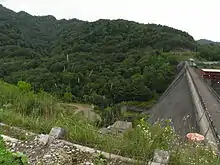Katsurazawa Dam
The Katsurazawa Dam is a dam in Hokkaidō, Japan. It was Hokkaido's first multipurpose dam and the post-war Ishikari River watershed development plan's starting point. The dam is a 63.6m in height Concrete Gravity dam, immediately downstream from the Shinkatsurazawa Dam. The artificial lake resulting from the construction of the Katsurazawa Dam is known as the Katsurazawa Lake.
| Katsurazawa Dam | |
|---|---|
 | |
| Location | Hokkaidō, Japan. |
| Coordinates | 43°14′23″N 142°00′09″E |
| Construction began | 1947 |
| Opening date | 1957 |
| Dam and spillways | |
| Impounds | Kushunbetsu River |
| Height | 63.6 m |
| Length | 334.3 m |
| Reservoir | |
| Total capacity | 92,700,000 m³ |
| Catchment area | 446.2 km² |
| Surface area | 499 hectares |
Overview
The construction of the dam would lead to the relocation of 172 households.[1] The dam's goals were to supply water for irrigation to Bibai Fields, Bibai City, Mikasa City, and also to produce up to 15,000 kW of Hydro Electric Power.[2]

Shin-Katsurazawa Dam (Modified Katsurazawa Dam)

View from an airplane
Wikimedia Commons has media related to Katsurazawa Dam.
References
- FUKADA, Atsuo (2003-07-01). "Study on the Cretaceous System around the Katsurazawa Dam on the Ikushumbetsu River". Annual Report. 4: 119–131.
- "桂沢ダムの概要". www.sp.hkd.mlit.go.jp. Retrieved 2017-03-18.
This article is issued from Wikipedia. The text is licensed under Creative Commons - Attribution - Sharealike. Additional terms may apply for the media files.